 |
 |
 |
| |
Geriatric syndromes and quality of life in older adults living with HIV in Brazil....50% Pre-frail, 6% frail....age 62, CD4 700+, 90% undetectable viral load....greater services needed !
|
| |
| |
From Jules: In this study while average age was only 56-68 years old 50% had pre-frailty & this is chatacterized by these PWH having as you can see just below in the Results slide .......high rates of polypharmacy & severe polypharmacy, cognitive decline, sarcopenia (muscle wasting), recent falls, reduced mobility, anxiety & depression & disability which means reduced ability to perform normal independent daily activities of daily living (IADLs) like food shopping, doing laundry, housekeeping, etc. All of this caused worsening quality of life. The number of conditions a person had correlated with QOL, meaning the more conditions a person had the worse QOL was. The authors say these older PWH need greater support services.
RESULTS: The median age of the 703 OPLWH enrolled was 62 years; 63% cis-gender men and 35% cis-gender women; median CD4 count 731 cells/μL; 88% undetectable HIV-RNA; and 21% had <8 years of education. Polypharmacy (77%) and any cognitive impairment (72%) were the most prevalent geriatric syndromes. Among all, sarcopenia was present in 40%, pre-frailty in 49%, and frailty 6%. Overall, 244 (35%) OPLWH had none/one geriatric syndrome, 195 (28%) two, 147 (21%) three, and 117 (17%) =4 geriatric syndromes. Greater number of geriatric syndromes was associated with lower QOL index (Figure A) and more severe problems for every QOL dimension (Figure B, p<0.001 for all).
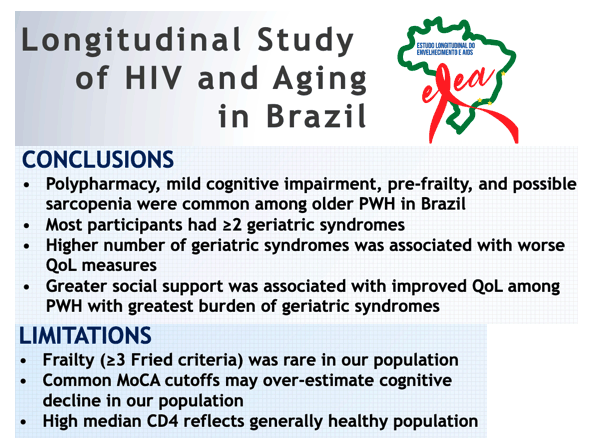
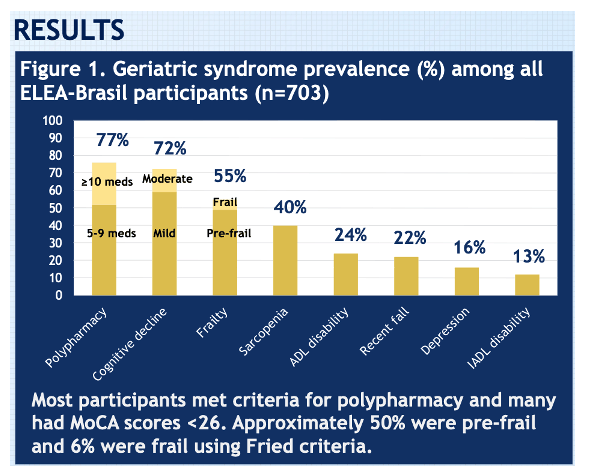
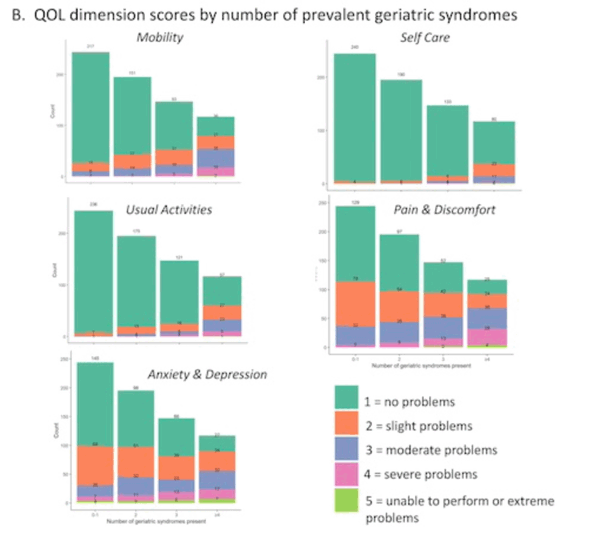
AIDS 2024 July 20-26 Munich
J.L. Castilho1, P. Ranadive2, B.E. Shepherd2, C. Brites3, T. Cordeiro3, S. Amaral3, R.S. Nogueira4, A.C.C. Iglessias4, M.B. Antonio5, V.I. Avelino-Silva5,6, S.W. Cardoso7, T.S. Torres7, B. Grinsztejn7, on behalf of ELEA-Brasil
Institutions
1Vanderbilt University Medical Center, Division of Infectious Diseases, Nashville, United States, 2Vanderbilt University Medical Center, Department of Biostatistics, Nashville, United States, 3Hospital Universitário Professor Edgard Santos, Laboratório de Pesquisa em Infectologia, Salvador, Brazil, 4CRT-DST/AIDS-SP (STD/Aids-SP Reference and Training Center), São Paulo, Brazil, 5Faculdade de Medicina da Universidade de São Paulo, Department of Infectious and Parasitic Diseases, São Paulo, Brazil, 6Vitalant Research Institute, San Francisco, United States, 7Instituto Nacional de Infectologia Evandro Chagas-Fiocruz, Rio de Janeiro, Brazil
BACKGROUND: Older people living with HIV (OPLWH) are a growing population globally. Understanding of the epidemiology and consequences of geriatric syndromes in diverse settings is urgently needed. We examined the association of geriatric syndromes and quality of life (QOL) among OPLWH in Brazil.
METHODS: We enrolled OPLWH aged =50 years on antiretroviral therapy from clinics in three Brazilian cities for standardized collection of geriatric syndromes, medical history, and sociodemographic information. Geriatric syndromes included frailty (Fried phenotype), polypharmacy (=5 daily medications), cognitive impairment (Montreal Cognitive Assessment score <26 adjusted for education), activities of daily living (ADL) dependency (Barthel scale<96), instrumental ADL dependency (Lawton scale<26), sarcopenia (Short Physical Performance Battery score <10), depression (PHQ-9 score =10), and any falls in the past year. QOL was measured using the EQ-5D-5L, which accounts for dimensions of mobility, self-care, usual activities, pain/discomfort, and anxiety/depression. We described the association of none/one or multiple prevalent geriatric syndromes with QOL composite index and QOL dimensions (no problems to extreme problems).
RESULTS: The median age of the 703 OPLWH enrolled was 62 years; 63% cis-gender men and 35% cis-gender women; median CD4 count 731 cells/μL; 88% undetectable HIV-RNA; and 21% had <8 years of education. Polypharmacy (77%) and any cognitive impairment (72%) were the most prevalent geriatric syndromes. Among all, sarcopenia was present in 40%, pre-frailty in 49%, and frailty 6%. Overall, 244 (35%) OPLWH had none/one geriatric syndrome, 195 (28%) two, 147 (21%) three, and 117 (17%) =4 geriatric syndromes. Greater number of geriatric syndromes was associated with lower QOL index (Figure A) and more severe problems for every QOL dimension (Figure B, p<0.001 for all).
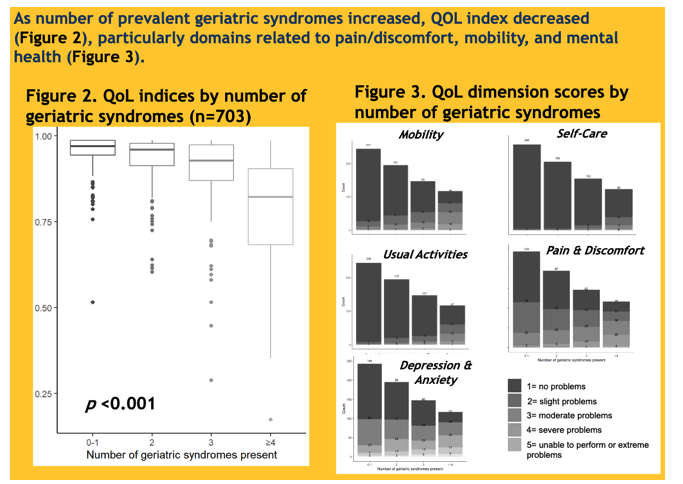
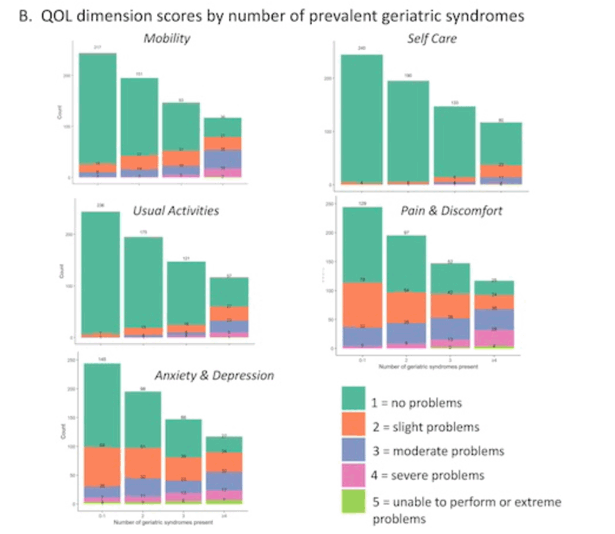
CONCLUSIONS: Geriatric syndromes were prevalent among OPLWH in Brazil, and higher burden of geriatric syndromes was associated with worse QOL. Improved screening for geriatric syndromes in OPLWH may improve health outcomes is this growing population.

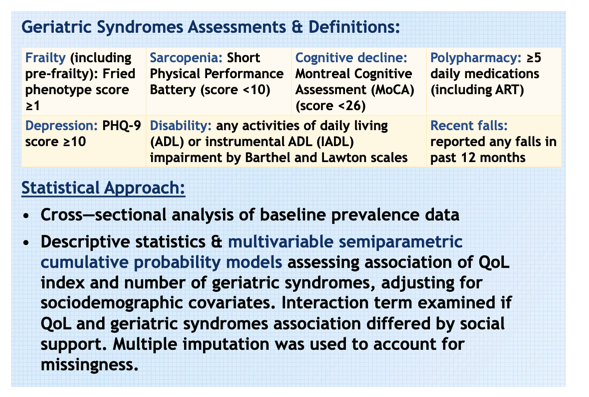
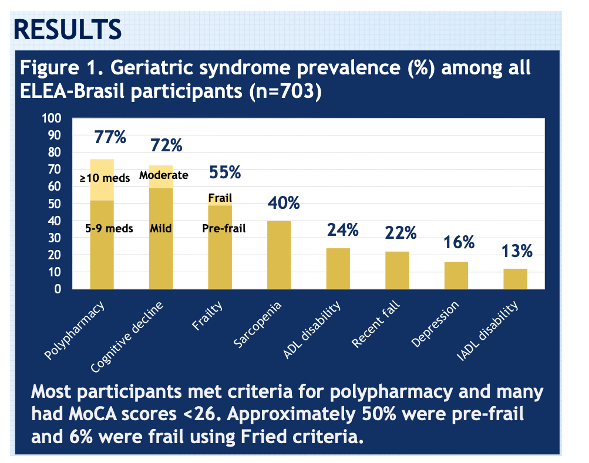
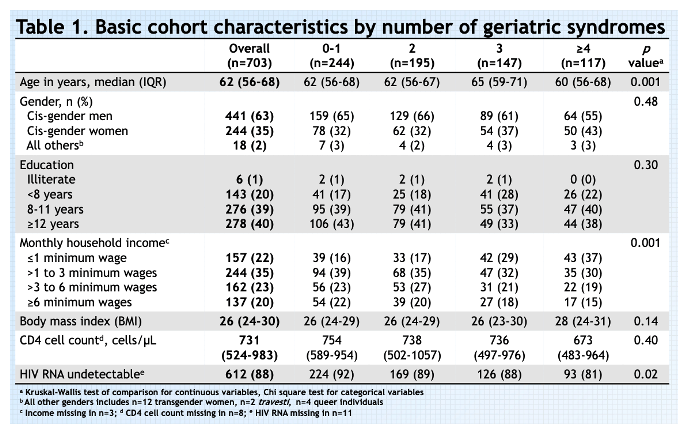
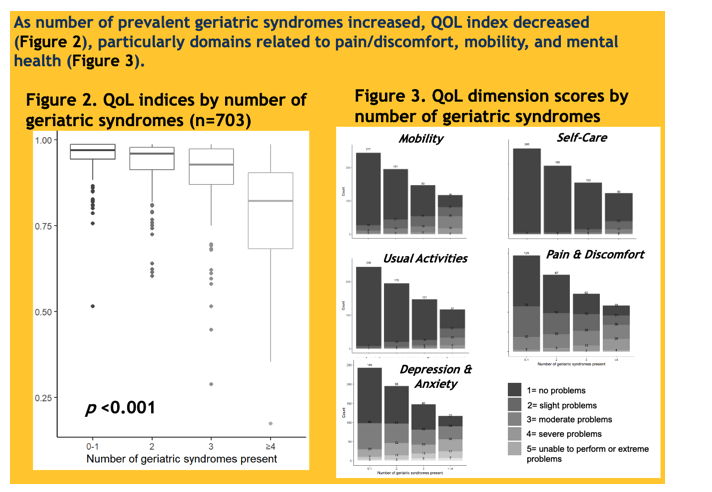


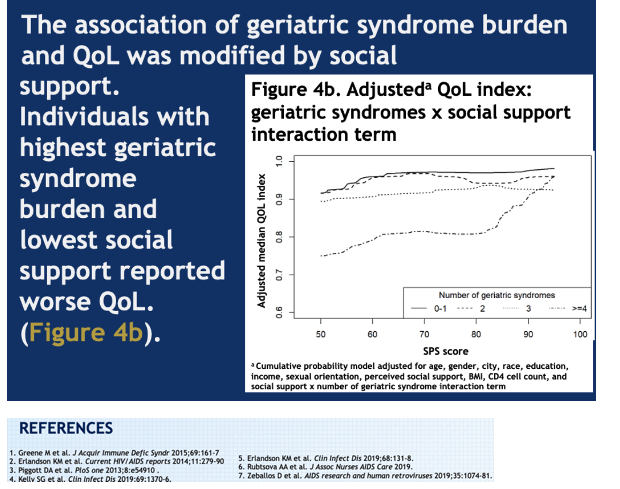
|
| |
|
 |
 |
|
|